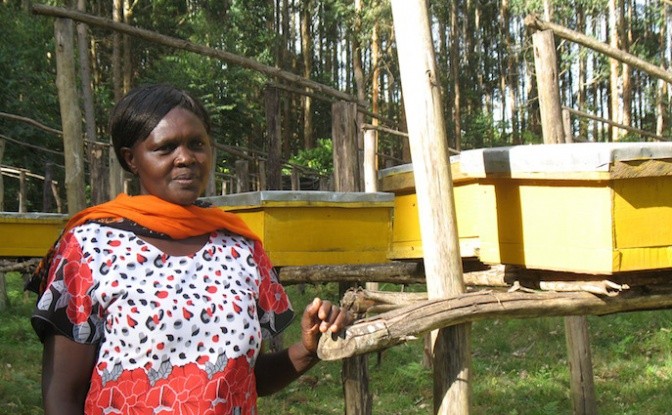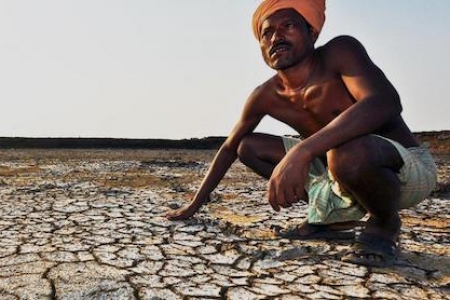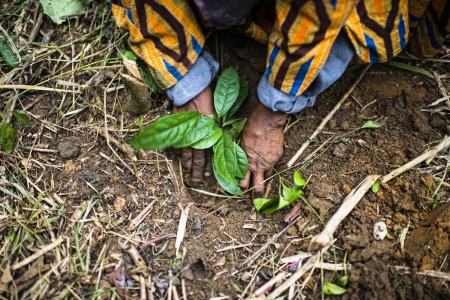Kenya hands control of resources over to local communities
Something interesting is happening in Kenya – something that, if successful, could reverberate through Africa and transform the continent’s landscape management. Formerly all-powerful state agencies, such as the Kenya Forest Service (KFS), are handing over day-to-day control of key resources like forests, rivers and the country’s totemic wildlife to local communities.
 Sarah Karungari is a Kimunye Community Forestry Association member working on one of the beehive projects. Photo: Fred Pearce
Sarah Karungari is a Kimunye Community Forestry Association member working on one of the beehive projects. Photo: Fred PearceIn a country where corrupt land grabs and misuse of natural resources was for many years endemic -- and under Daniel Arap Moi began in the President’s office -- this looks like good news.
Take forests. For many years, the KFS was a quasi-military organisation in charge of huge swathes of forest, and often run by former soldiers still wearing fatigues. For them, people who lived near the forests were regarded as a problem, if not the enemy.
But now, that same organization is handing control of the forests to those same people, through democratically elected Community Forest Associations. Hundreds of CFAs are already established, and more are planned. They are charged with ensuring sustainable use of the forests, managing and raising fees for grazing of livestock or firewood cutting, and preventing illegal activity.
Communities do a better job
“Nowadays most of the forest patrols are done by communities, and our job is to support them,” says John Wachihi, head of conservancy for KFS in Kenya’s central highlands. “The CFAs are changing peoples’ attitudes to conservation. In the long run we want them to be self-sustaining, to use fees they generate from allowing use of the forests to invest in economic enterprises that will take pressure off the forests.”
After CFAs come Water Resource User Associations (WRUAs), intended to reconcile the needs of upstream and downstream water users in river catchments, and to protect riparian habitats like river banks and floodplains.
And there are plans too for Wildlife User Associations (WUAs). Involving communities in wildlife management makes the country’s national parks more secure, says Silas Marewi, a Kenya Wildlife Service warden for the Aberdare Mountains. “When we get communities involved, they call us up when they see poachers or hear that people are recruiting poachers in their villages. That never used to happen.”
There are plans to allow WUAs to establish game-farming enterprises, he says. Already there are projects breeding quails and guinea fowl – and even chameleons for the pet trade. The thinking, says Marewi, is that if the communities can make money that way, they won’t want to get involved with poaching or charcoal burning in the forests.
Some doubt whether village communities really can protect landscapes and natural resources. In particular, they see farming and cattle grazing round the national parks and forested uplands as an ecological threat. It can be. But according to the Kenya Wildlife Service’s assistant director for mountain conservation, Aggrey Naumo, the surprising truth is that biodiversity is greater outside the protected areas than inside.
To me conservation is about people. If you focus on wildlife and forget about people, you will lose. - Aggrey Naumo
We met over breakfast in a tourist lodge in the Aberdare National Park, with elephants grazing only a few metres away outside the window. But he said, “mountain parks, like those here in the Aberdares and Mount Kenya, may have lots of charismatic animals, but they have much less biodiversity than many of the farmed areas outside”.
The primary reason is the elevation: biodiversity here decreases as you go up hill. But farmers must be doing something right to keep so many species of plants, insects, small mammals and birds thriving on their land. It is certainly no accident. The farms are patchworks of different crops, often interspersed with many trees, growing for firewood, fruit, construction materials and much else.
“Farming communities know their ecosystems better than outsiders,” Naumo said. “Better than my managers. We have to work with farming communities if we want to protect ecosystems. To me conservation is about people. If you focus on wildlife and forget about people, you will lose.”
This wholesale devolution of control of nature to communities has not happened because governments are downgrading the importance of these resources. Quite the opposite. But under the country’s 2010 constitution, important things are being devolved away from the hands of centralised political patronage and, it is hoped, scoped for rampant corruption.
But access to water remains an issue
Wildlife retains its importance for the tourist economy. And upland forests are increasingly recognised as the nation’s “water towers”. They only represent 2 per cent of Kenya’s land area, but most of the country’s rivers rise in these regions. They are the ultimate source of most of the nation’s water supplies and electricity.
Not all government activities have been devolved, however. Ministers remain determined to push ahead with big centralised projects, like intensive state-sponsored high-tech irrigated farming. But this kind of farming is seriously overstretching fragile environments and undermining ecosystem services. In the capital Nairobi, they seem to forget about the environmental constraints.
More than two-thirds of the water abstracted from rivers in Kenya now goes for irrigation. But however well the ecosystems of the critical water towers are protected, they cannot meet such demand. Water managers know this, but agricultural planners refuse to listen, according to the head of the Water Resources Management Authority, John Olum. “Irrigation projects are being designed by government bodies without our participation,” he told me.
This year, the most obviously symptom of that failure is on the River Tana, the country’s longest river, which drains from the Aberdares to the Indian Ocean. The government has sunk tens of millions of dollars into the 400,000-hectare Galana irrigation project, which takes its water from the river. The project is due to open later this year. But government hydrologists reported in January that the river was not up to the job of filling the project’s canals and watering its crops. In fact, it would be able to irrigate only a 2 per cent of the project’s fields.
A camel caravan for a new concordat
Another looming disaster is on the river Ewaso Ngiro, which drains from the glaciers of Mount Kenya through forests, farmlands and grazing pasture to the Lorian swamp in the country’s arid northeast. The swamp is an oasis for wildlife, particularly crocodiles, and both it and the river’s lower floodplain are valued dry season pasture for millions of cattle.
The river used to flow year-round, but in recent times water has typically failed to reach the swamp for around 100 days in a year. The reason is massive abstractions for horticulture. In 2013 Samburu, Turkana and other pastoral communities, left high and dry, grabbed media attention for their plight by organising a camel caravan to travel upstream and calling for a new concordat the share the river’s water more fairly.
In the old days that might have just been a protest that fizzled out with the next rains. But this time WRUAs are taking up the challenge. There is no resolution yet. But the dialogue suggests that Kenya is onto something. The best hope for effective landscape management may be to devolve power to the people who use the resources -- and have the incentive to care for them.
Read more from the Tana River Basin:











